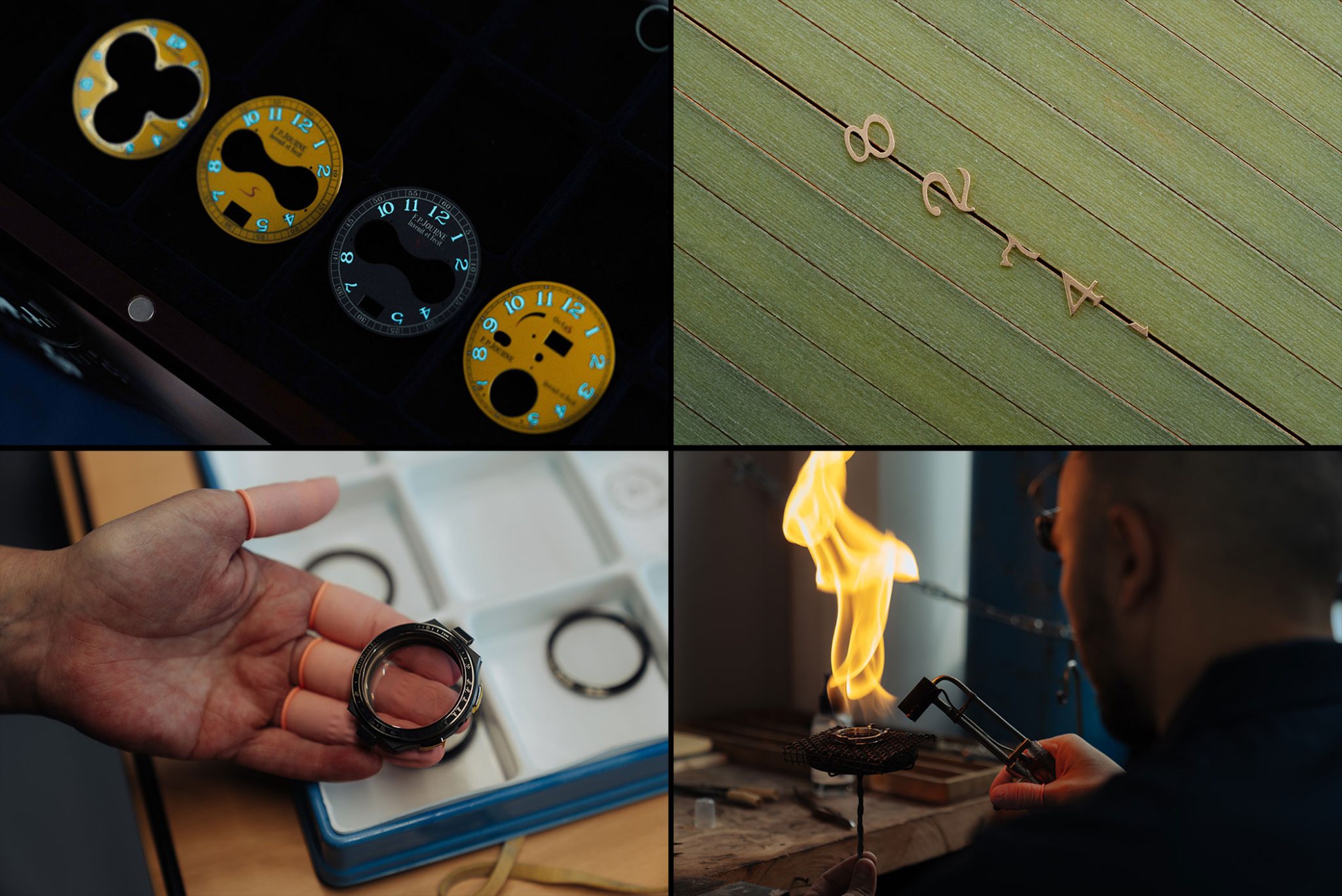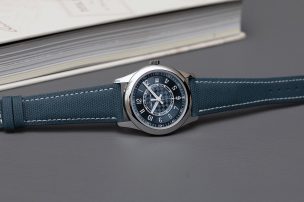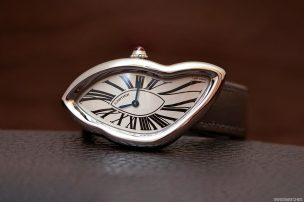

F.P.Journe’s lineSport Collection: When Ambition Meets Zeitgeist
Geneva is the city of watchmaking, and many of the largest and best-known watch manufactures in the region have long opted to confine their points of sale to the city centre. F.P. Journe, however, is different. Located in a historic building on Rue de L’Arquebuse dating from 1892, very close to the flagship boutiques around Rue du Rhone, François-Paul Journe’s watchmakers have been assembling its coveted models for almost 25 years. Amongst its portfolio are three particular variants of the lineSport collection.

There is also now a showroom here, which used to comprise the entire workshop. Like the adjoining meeting room, however, it is mainly intended as a space for business meetings. After all, the brand has a boutique over at Place de Longemalle, where all the watches are delivered to the customers. Yet, it is right here, on Rue de L’Arquebuse, that we are presented with the company’s finished timepieces, at the very place where they were created. But before taking a look at the F.P. Journe lineSport models and their siblings from the other collections up close, guests can pay a visit to the ateliers on the first floor. Each watchmaker here is responsible for the production of one complete calibre. The closer you get to the office of company founder, François-Paul Journe, the more experienced the watchmakers become – and the more complicated the watches get.

F.P.Journe in Geneva at Rue de L‘Arquebuse
Extravagant down to the last detail: The F.P.Journe lineSport collection
If François-Paul Journe is known for one thing aside from his products, it is the fact that he likes to be in control. This attention to detail, the high demands he places on his products (and therefore on his employees) is what gives the entire collection its special identity. It’s no exaggeration to say that Journe was already embracing the idea of independent watchmaking long before the concept was even prevalent in the industry. In the meantime, he has created a team of confidants around him who share his vision – and in this orchestra of horological free spirits, Journe is a conductor, stage builder, and usher all at once.

When creating the lineSport collection, F.P. Journe certainly did not take the easiest route. Legend has it that the first ‘sports watches’ were created at the request of a Japanese collector. The collector had radically reduced his body weight with the help of excessive running training, and wanted a F.P. Journe that he could wear in his next marathon. The result was the very first Centigraphe Sport, which was made entirely of aluminium and weighed just 55 grams, including the bracelet. The watch was spontaneously auctioned off in 2011 in aid of the victims of the Fukushima nuclear disaster for around half a million dollars – ten times the intended sale price. The buyer was, incidentally, none other than the same late-career endurance athlete.

Since then, the F.P. Journe lineSport series has continued to evolve, and the catalogue currently includes three different models in different materials: there is the Automatique Réserve with a 160-hour power reserve, the Chronographe Rattrapante for stopping split times and, of course, the Centigraphe, the exceptional watch that allows time to be recorded to the nearest hundredth of a second. The hundredths-of-a-second hand races around the subdial counter at the 10 o’clock position once per second, while 20-second intervals are measured at 2 o’clock and 10 minutes at 6 o’clock. All this takes places thanks to a 3 Hz hand-wound calibre, working comparatively slowly at 21,600 beats per hour, which, in this case, actually helped watchmaking genius Journe to stop particularly precisely by making use of the resulting sixth of a second measurement, in that the racing foudroyante second at the 10 o’clock position really can be stopped at any time – even between the 1/6 jumps. This is largely made possible by the central positioning of the mainspring barrel in the calibre. The driving wheel of the hundredths of a second hand is vertically separated from the driving wheel of the escapement, which presses on the shaft and acts as a brake.

Aluminium was abandoned relatively quickly – after just two years. As innovative as the decision to use aluminium was, the material was just as challenging to produce: for example, anodising the aluminium to protect it against corrosion and make it more robust for everyday wear on the wrist. Achieving an even finish with a uniform colour proved to be extremely difficult. At the time, around 60 percent of the production did not meet the aesthetic requirements and were therefore not used. Thus, the watches are now manufactured in titanium, 18-carat 6N gold or platinum, and in typical Journe fashion, the movement of the precious metal versions is made of 18-carat rose gold; only the titanium models are still made of aluminium. In terms of weight, the precious metals contradict the original lightweight claim, but the feel of the platinum Centigraphe in particular is simply too impressive not to enjoy at least as much.

Everything from a single source: Vertical production à la Journe
It is a well-known fact that there are various manufactures who have been achieving horological feats for many decades and whose classic timepieces are the epitome of style and class. However, the most sought-after and celebrated by the zeitgeist are the so-called ‘sports models’ from these manufactures. With F.P.Journe, the situation is – at least for the time being – somewhat different. The bracelets and dials of the sports models are impressive proof of the company’s outstanding product quality and uncompromising approach. Sporty? Of course. Typical F.P.Journe? Absolutely.

As already mentioned, Monsieur Journe likes to keep an eye on the entire production of his timepieces. Trusting others is good, but doing it yourself is always better – especially since, as a niche independent manufacture, it is sometimes difficult to gain a status with suppliers that enables you to be heard at all times. Or, to put it another way, whoever delivers the most turnover understandably has more creative power with external producers than the small manufactures, which only fill residual capacities.

The workshops of “Les Cadraniers de Genève” and “Les Boîtiers de Genève” in Meyrin near Geneva
The recent opening of the new workshops Les Cadraniers de Genève and Les Boîtiers de Genève in the industrial area of Meyrin near Geneva can thus be described as an essential building block for the future of F.P.Journe, and an entrepreneurial feat to boot. This is where the dials, cases, and bracelets for F.P.Journe are produced. Journe founded Les Cadraniers de Genève together with Harry Winston and later continued in partnership with Vacheron Constantin. Since 2016, however, he has been the sole owner of both companies. Production is primarily for himself, but he also supplies some renowned competitors with high-quality dials, indices etc.

A total of 70 employees at the workshop produce the highest quality dials, cases, and bracelets by hand, alongside state-of-the-art machines and finishing techniques – and guarantee F.P. Journe the kind of independence that other mini- and micro-brands can only dream of. At the same time, the lineSport collection is a showcase for the subsidiaries. The indices are infinitely fine, the in-house luminescent material shines brighter than anywhere else, the quality of the titanium cases sets its own standards, and the matt finish of the platinum and gold cases alongside the matching bracelets is truly unique.


Since 2018, the F.P. Journe lineSport models, which were previously produced in 42 mm cases, have stood out due to their sheer size. With a diameter of 44 mm, the Automatique Réserve, Chronographe Rattrapante and Centigraphe sport version are now considerably larger than the models in the Classique collection. However, thanks to the virtually non-existent lugs, they are much smaller than pretty much all other 44 mm models, and the titanium version in particular gives you a feeling of the special value that lightness should always hold in life.

Demand and supply: The collector’s dilemma
F.P. Journe now produces around 1,000 mechanical watches, alongside 500 pieces from the èlègante collection using what is probably the most sophisticated quartz movement on the market. This makes F.P.Journe one of the bigger players amongst the small ones, but compared to manufactures such as Audemars Piguet or Patek Philippe, it still serves the niche within the niche. At the same time, this niche is becoming increasingly popular, which poses the following challenge for small and independent brands: the old collectors, i.e. those who have been with them for many years and have been so even in more challenging times, should and must continue to be valued. At the same time, new customers and collectors should also be given a chance. A visit to the Geneva manufacture makes clear that the overriding criterion is a credible passion for the craft and the company’s timepieces.


When F.P. Journe talks about collectors, it does not automatically mean owners of dozens of models; a collection can also consist of just two or three models. The aim is to meet the high demand in some way. The sales staff, working in the twelve boutiques from Paris to London to Dubai, Bangkok, and Los Angeles, are trained accordingly in knowledge of human nature. The shopping experience should be a pleasant one; not an application process or an investment pitch, but rather a mutual familiarisation so that expectations on both sides are not let down.

The fact that even the èlègante models are now highly sought-after doesn’t make things any easier. But a lineSport guy does not necessarily have to be a Classique guy, and it is precisely because of the impressive quality and finesse of the products across all segments that many a watch collector first has to work out: which F.P.Journe particularly appeals to me?

From a scribble on a napkin to the manufacture of the hour
A framed paper napkin hangs in a presentation room in Rue de L’Arquebuse. François-Paul Journe sketched his first idea of a watch with his own name on the dial on this napkin 30 years ago, and this first draft impressively demonstrates how precisely Journe already knew what he wanted back then – and what aesthetic the watches should have. The shape of the case, hands, and indices has barely changed since then. It is this watchmaking genius, combined with his aesthetic vision, and the strength to realise his ideas under his own name and without compromise, that has brought F.P. Journe to its current position of immense strength. One man decides all. What began in a small studio now occupies the whole building and employs around two hundred men and women worldwide. The master of the horology house has collected dozens of prizes for his innovations. The manufacture openly admits that the watches are ultimately not so much known for their particularly exquisitely finished movements, but that the calibres themselves are horological highlights. Journe launched the lineSport because he listened to his collectors – it was long before luxury sports watches became a big topic everywhere. He prescribed yellow dials for his titanium models, which was certainly not a decision based on popular taste, but a deep conviction that this combination was dynamic and therefore appropriate.

A few months ago, the F.P. Journe restaurant opened in the centre of Geneva. Together with former Michelin-starred chef Dominique Gauthier, the pair have created the Journe interpretation of a brasserie: high-quality ingredients, perfect craftsmanship, a sense of aesthetics, plus a dose of elegance and savoir-faire. While lunch and dinner are served from Monday to Thursday, the restaurant is only open at lunchtime on Fridays and not at all during weekends. Out of consideration for the chef’s quality of life, there is no business on what are traditionally the days with the highest turnover – a foolish idea from the point of view of traditional restaurateurs. However, the place is always busy, and without a reservation, nothing will usually get you in.

F.P. Journe enjoys doing things a little differently from everyone else. The only thing you can be sure of is that even while the chef is enjoying the weekend, the restaurant’s namesake is cooking up new plans.











